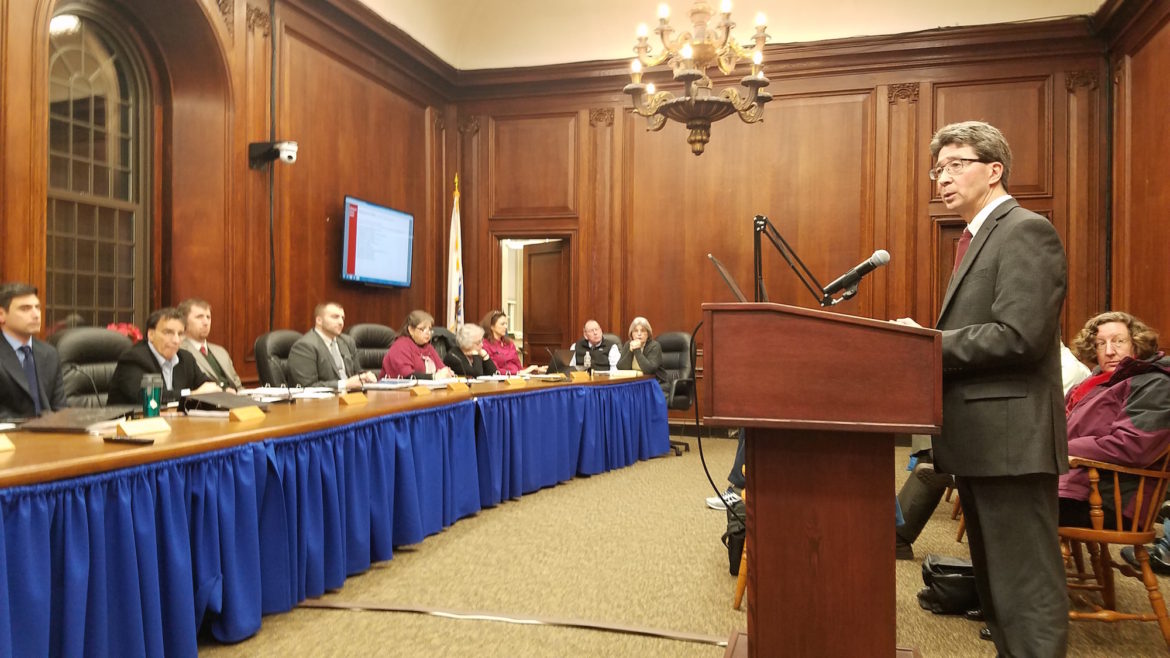
Charlie Breitrose
Joel Seeley from SMMA presents the Watertown Schools Master Plan to a joint session of the School Committee and Town Council.
The School Master Plan presented to a joint meeting of the School Committee and the Town Council provided some insight into Watertown’s schools, but opened many more questions.
The Master Plan incorporated the work of the Master Plan Steering Committee, which included parents, staff and elected officials, as well as, input from three community meetings and interviews with school staff and administrators, said School Committee Chairman John Portz.
Representatives from SMMA, the firm hired to create the master plan, included cost estimates for three different options for improving the schools. Option 1 would be bringing the schools into good working conditions, but would not make major changes to the current configurations. Option 2 would renovate the schools and would make some changes inside so the buildings can handle 21st Century education, with more group and project learning and flexible spaces. Option 3 would be to build brand new buildings.
At Hosmer, there is an extra option to build and addition to create a universal early learning center for the district.
Estimated Costs of Renovating or Rebuilding Watertown’s Schools
| Option 1 | Option 2 | Option 3 | |
| Cunniff Elementary | $26.5 million | $29.8 million | $55.4 million |
| Hosmer Elementary | $29.9 million | $40.7 million/$54.4 million | $71 million |
| Lowell Elementary | $28.3 million | $30 million | $60.7 million |
| Watertown Middle School | $35.3 million | $46.3 million | $86.7 million |
| Watertown High School | $44.9 million | $53.4 million | $131.5 million |
The plan does not provide exact costs of the project, but rather is a high-level look at the schools, said Joel Seeley, of SMMA. He noted that the figures are based on construction starting in mid-2018, and would likely rise if work starts later.
“These are not final designs, they are conceptual models to provide the framework or guidelines for the town to follow to (reconstruct) the public schools,” Seeley said.
The Master Plan did not recommend which option the district should take for each school or the entire district.
Town Councilors and School Committee members wanted to know what the next steps would be. Seeley said the district will have to decide which option to take, do more detailed designs to get more accurate prices for the work and come up with a sequence for when to do the work on each school. Not necessarily in that order.
Seeley said doing a feasibility study could help officials get more detailed information on which to base the decisions.
Portz suggested the Master Plan Steering Committee have another meeting to review the final Master Plan, and the School Committee could then vote to approve the master plan.
Town Councilor Vincent Piccirilli said that the Steering Committee did not take a formal vote on which option to take, but leaned toward Option 2.
“If they spend $160 million to do basic renovation, and spend a little more to be set for the next 50 years is worth the investment,” Piccirilli said.
One thing the Master Plan lacked was details about what the schools lack now, said Town Councilor Aaron Dushku.
“For instance, at Lowell, there is no computer lab, and the computers are in the library and it is cramped,” Dushku said. “As we look ahead to the next phase when we need to generate support from the community. We need those compelling stories.”
Interim Superintendent John Brackett said the district needs to have a discussion about what 21st Century learning will look like in Watertown.
“If you ask education experts you get a number of answers,” Brackett said. “What it looks like in the classrooms, and in the common spaces, is where we bring in our educators (to discuss).”
The district must also talk about the bottom line – how the construction will be paid for. Seeley said Watertown might be able to get money from the Massachusetts School Building Authority to reimburse the district for some of the costs of work, but it is highly unlikely Watertown would get state money for all the schools.
Portz said he sees three main next steps, which could run in parallel: 1) a request for proposals for a feasibility study, 2) community engagement, and 3) educator engagement.
Town Council President Mark Sideris said there will be a lot of work ahead to get all the work completed, but it can be done.
“We shouldn’t be afraid of it. We should try to find a solution,” Sideris said. “We need to be partners with the town because we are using taxpayer dollars to fund improvements for education.”
Just get it done already, stop talking, get the official quotes for option 2 and get it done. At this rate its going to be 2020 before anything gets done and in the meantime we’ll still have overcrowding and deteriorating school buildings. Why do they move so slow?
Hire the development teams that have overbuilt Pleasant street. ….seems like they can design, plan, approve, and build faster than anything proposed here!